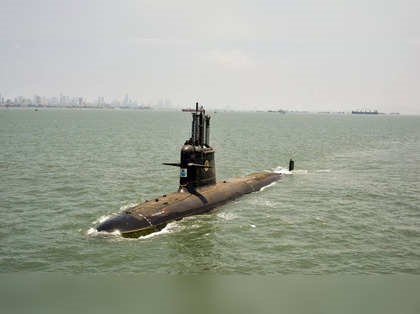Description

Disclaimer: Copyright infringement not intended
Context: Larsen and Toubro (L&T) and Defence Research and Development Organisation (DRDO) have signed a deal to manufacture two Air Independent Propulsion (AIP) modules for the Indian Navy's Kalvari class submarines.
About the AIP module deal
- The AIP module has been designed by the Naval Materials Research Laboratory (NMRL), a DRDO lab.
- NMRL will transfer the technology to manufacture these AIP modules to L&T.
- It will be manufactured by the Larsen and Toubro (L&T) and Defence Research and Development Organisation (DRDO).

AIP module
- Air-independent propulsion (AIP), or air-independent power, is any marine propulsion technology.
- It allows a non-nuclear submarine to operate without access to atmospheric oxygen (by surfacing or using a snorkel).
- AIP can augment or replace the diesel-electric propulsion system of non-nuclear vessels.
- AIP is usually implemented as an auxiliary source, with the traditional diesel engine handling surface propulsion.
- Most such systems generate electricity, which in turn drives an electric motor for propulsion or recharges the boat's batteries.
About Kalvari class submarines
- The Kalvari class is a class of diesel-electric attack submarines.
- They are the Scorpène-class submarine being built for the Indian Navy.
- The class and submarines take their names from the first submarines inducted into the Indian Navy.
- The submarines are designed by the French naval defence and energy company DCNS and are being manufactured by Mazagon Dock Limited in Mumbai.
- The Kalvari class is capable of offensive operations across the entire spectrum of naval warfare including anti-surface warfare, anti-submarine warfare, intelligence gathering, mine laying and area surveillance.
|
PRACTICE QUESTIONS
Consider the following statements about “Kalvari class submarines”
- The Kalvari class is a class of diesel-electric attack submarines.
- The submarines are designed by French naval defence and energy company DCNS and are being manufactured by GRSE, Kolkata.
Which of the above statements are correct?
- 1 only
- 2 only
- Both are correct
- None are correct
Ans: 1
|
https://epaper.thehindu.com/ccidist-ws/th/th_delhi/issues/40778/OPS/G0MBD464U.1.png?cropFromPage=true
















